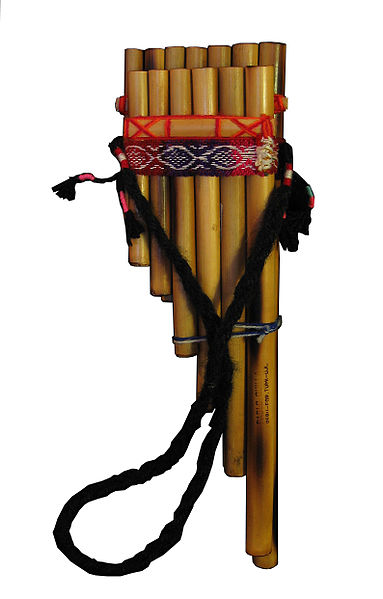Flutes are probably the oldest of the man-made musical instruments. A cut bamboo might have served as the first resonating column and the wind, the first flautist that inspired a passerby nomad. My guess is that the first flutes probably looked like the pan flutes shown below –

Image – Courtesy : Wikipedia
I theorize that the idea of making multiple holes within the same bamboo and to cover/uncover holes to produce different notes requires some ingenuity and would have taken several centuries if not millenniums before we got a transverse flute that looks like the one below –

Image – Courtesy : Wikipedia
This kind of transverse flute was independently invented by the Europeans and the Indians. The association of flute with Krishna (Indian god and an Avatar of Vishnu) indicates that this instrument was already quite popular around 2000 BC. Given that Krishna was a cowherd and played “cool” folk tunes for Gopikas, Krishna’s flute was probably closer to the relatively short south Indian Venu or the smaller versions of Bansuri than the modern north Indian bass Bansuri. Infact, it took nearly 4000 years before the Indians reinvented the Bansuri. Pannalal Ghosh(1911-1960) was one of the first musicians to employ the Bansuri for serious Hindustani Classical Music. In the process, he experimented with the bore size, number of holes and the length of the flute to invent the bass Bansuri that I am going to describe in more detail in this article.
A typical Bansuri covers 2 octaves. Depending on the construction quality and the bore size, some notes of the 3rd octave can be played too. Smaller bore sizes allow reaching higher octaves. Why? Smaller bore size means lesser volume of air. To sustain the standing waves in the flute takes a lot of energy. And to sustain notes of the higher octave takes even more energy. Therefore, with lesser volume of air, the higher modes of vibration become more viable.
You can hear me playing a D4 flute below. The notes are D4 (fundamental), D5 (first harmonic, 2x) and A5 (second harmonic, 3x). I paid nearly 66$ for this flute and it is totally worth it.
What is this D4?? This is the lowest note that this Bansuri can play (technically, there is one more lower note, but this where the transposed C starts for this flute. In other words it is the scale of the flute). In Indian musical terminology, this would be Re. The fundamental frequency is 293.66Hz.
The Bansuri like all other flutes uses a resonating column of air to produce the various notes. The blowing end has a cork that blocks the energy from escaping from the blowing end. The other end is the first open hole. The fundamental mode of resonance has nodes on both the ends and just one antinode in between. Therefore the length of the column is half the wavelength. Here is an interesting puzzle.. If you actually measure the distance between the open ends, multiply this distance by 2 and name the value is λ, divide the speed of sound (c)by this λ, you would get a frequency that is higher than the note that you hear when you blow. Infact, when I tried this, I got an error of 10% !!!. Engineers like me would be jobless if simple mathematical models worked. Thank god, they don’t. The devil is always in the details. The actual phenomena is much more complicated than the simplistic theories of a both ends open pipe. For starters, the energy does not escape efficiently from only one hole. The next hole plays a part too. To test this, I tried closing the next hole and got a variation in the frequency. This proves that the simplistic assumption that only the closest open hole plays a role in deciding the frequency is wrong. Therefore, it means that the effective length of the column is actually more than the distance between the blowing hole and the first open hole. Experts who make flutes have to take this into account among several other such non-idealities. It is no surprise that a good concert Bansuri sometimes costs more than 10x that of a normal one.
To be cntd… The most important part – Playing the Bansuri

Very good info. Lucky me I found your website by accident (stumbleupon).
I’ve saved it for later!